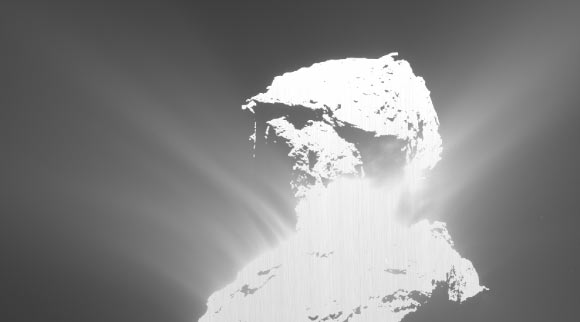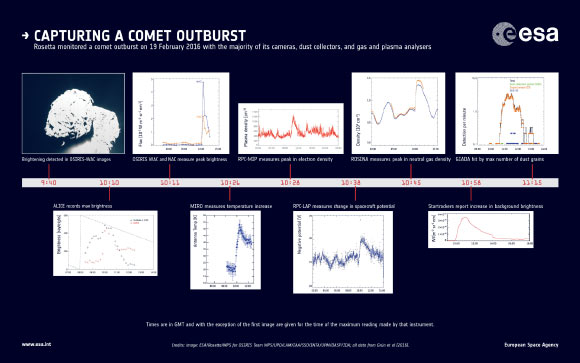In February 2016, nine instruments onboard ESA’s Rosetta spacecraft serendipitously observed an outburst of gas and dust from the Atum region on Comet 67P/Churyumov–Gerasimenko’s large lobe.

This dramatic outburst from the nucleus of Comet 67P/Churyumov-Gerasimenko occured on February 19, 2016. Image credit: ESA / Rosetta / MPS for OSIRIS Team / MPS / UPD / LAM / IAA / SSO / INTA / UPM / DASP / IDA.
The data were sent to Earth only a few days after the outburst, but subsequent analysis has allowed a clear chain of events to be reconstructed, as described in a paper in the Monthly Notices of the Royal Astronomical Society.
A strong brightening of the comet’s dusty coma was seen by Rosetta’s OSIRIS wide-angle camera at 09:40 a.m. GMT on February 19, 2016, developing in a region of the comet that was initially in shadow.
Over the next two hours, Rosetta recorded outburst signatures that exceeded background levels in some instruments by factors of up to a hundred.
For example, between about 10.00-11.00 a.m. GMT, ALICE saw the UV brightness of the sunlight reflected by the nucleus and the emitted dust increase by a factor of six, while ROSINA and RPC detected a significant increase in gas and plasma, respectively, around the orbiter, by a factor of 1.5–2.5.
In addition, MIRO recorded a 30-degree Celsius rise in temperature of the surrounding gas.

Evolution of the 19 February 2016 outburst. Image credit: ESA / Rosetta / MPS for OSIRIS Team / MPS / UPD / LAM / IAA / SSO / INTA / UPM / DASP / IDA / E. Grün et al.
Shortly after, Rosetta was blasted by dust: GIADA recorded a maximum hit count at around 11:15 a.m. GMT. Almost 200 particles were detected in the following three hours, compared with a typical rate of 3–10 collected on other days in the same month.
At the same time, OSIRIS camera images began registering dust grains emitted during the blast.
Between 11:10 a.m. GMT and 11:40 a.m. GMT, a transition occurred from grains that were distant or slow enough to appear as points in the images, to those either close or fast enough to be captured as trails during the exposures.
In addition, the startrackers, which are used to navigate and help control Rosetta’s attitude, measured an increase in light scattered from dust particles as a result of the outburst.
“Even the electron density at Rosetta increased by a factor 3 and consequently the spacecraft potential changed from -16 V to -20 V during the outburst,” the scientists said.
Astronomers on Earth also noted an increase in coma density in the days after the outburst.
By examining all of the available data, scientists believe they have identified the source of the outburst.
“From Rosetta’s observations, we believe the outburst originated from a steep slope on the comet’s large lobe, in the Atum region,” said lead author Dr. Eberhard Grün, of the Max-Planck-Institute for Nuclear Physics, Heidelberg.
The fact that the outburst started when this area just emerged from shadow suggests that thermal stresses in the surface material may have triggered a landslide that exposed fresh water ice to direct solar illumination.
The ice then immediately turned to gas, dragging surrounding dust with it to produce the debris cloud seen by OSIRIS.
“Combining the evidence from the OSIRIS images with the long duration of the GIADA dust impact phase leads us to believe that the dust cone was very broad,” Dr. Grün said.
“As a result, we think the outburst must have been triggered by a landslide at the surface, rather than a more focused jet bringing fresh material up from within the interior, for example.”
_____
E. Grün et al. The 19 Feb. 2016 outburst of comet 67P/CG: A Rosetta multi-instrument study. MNRAS, published online August 25, 2016; doi: 10.1093/mnras/stw2088








